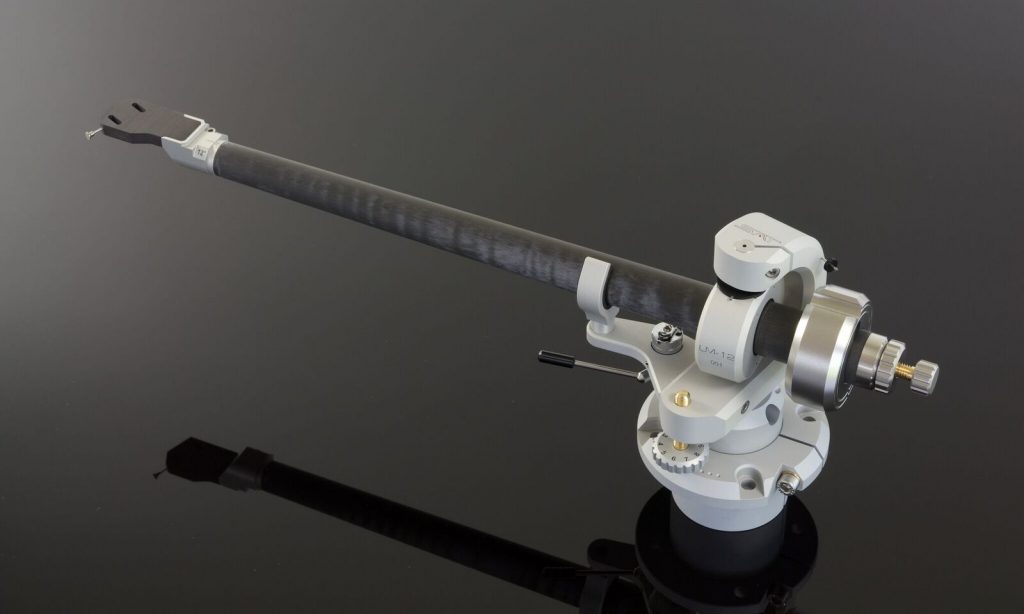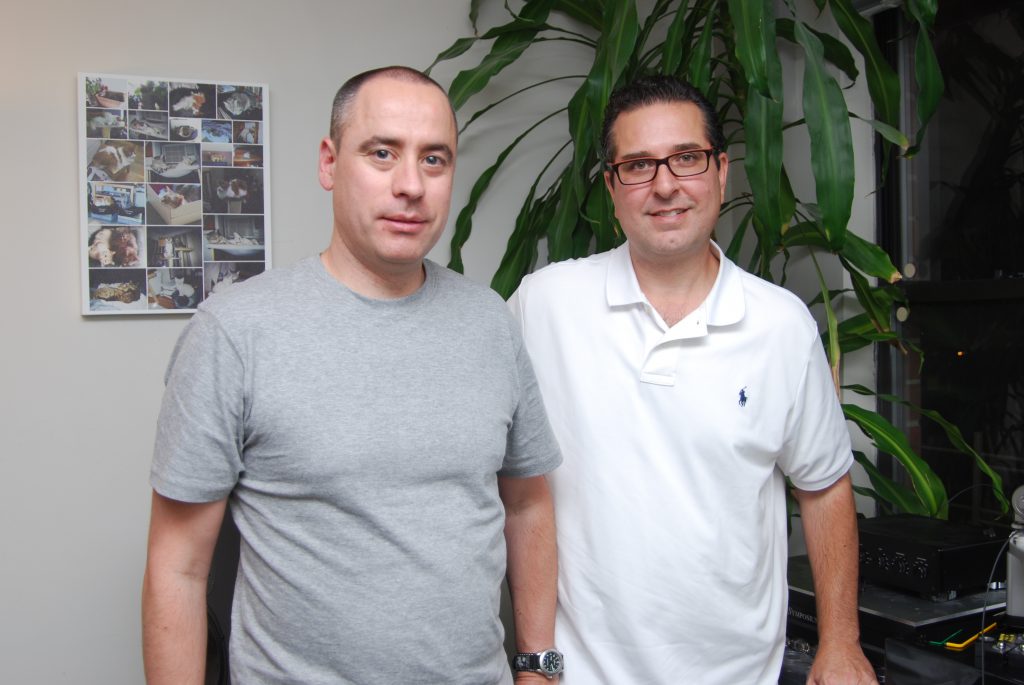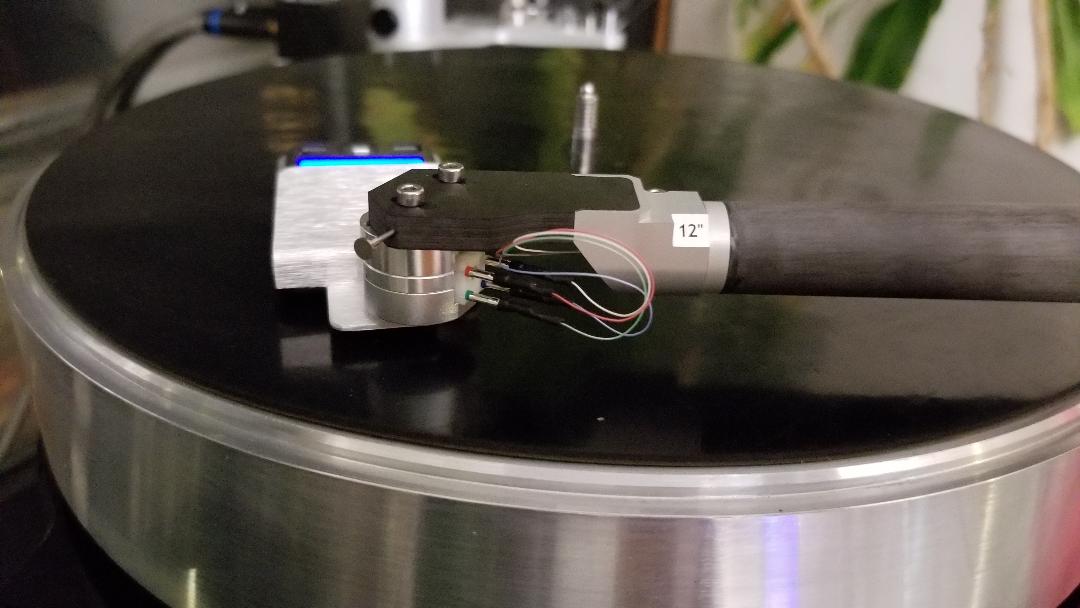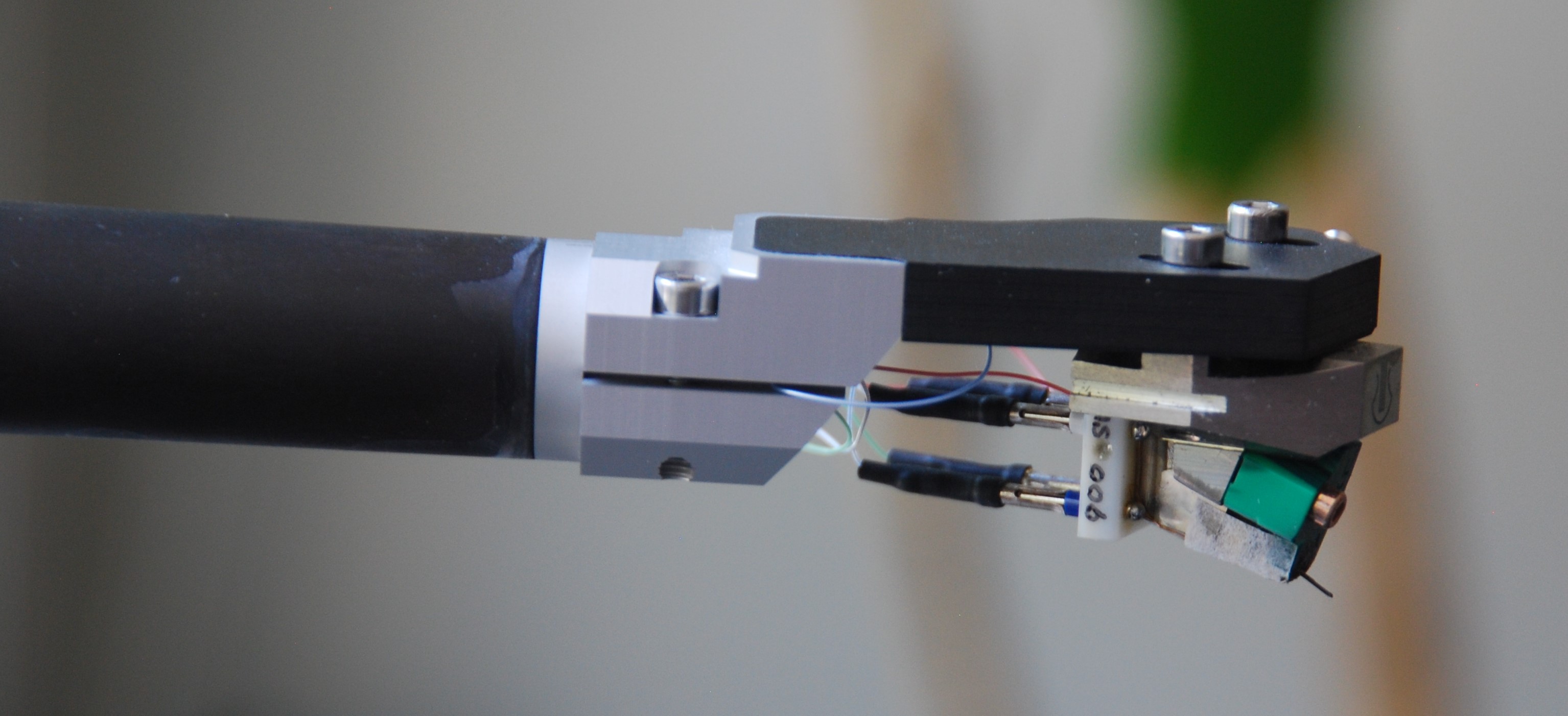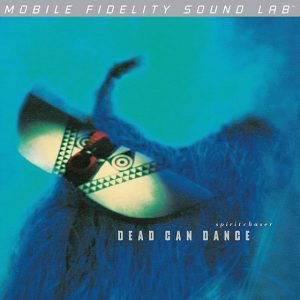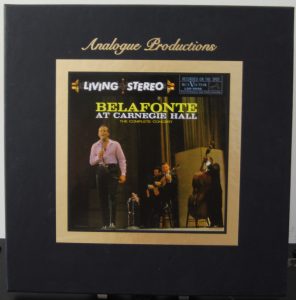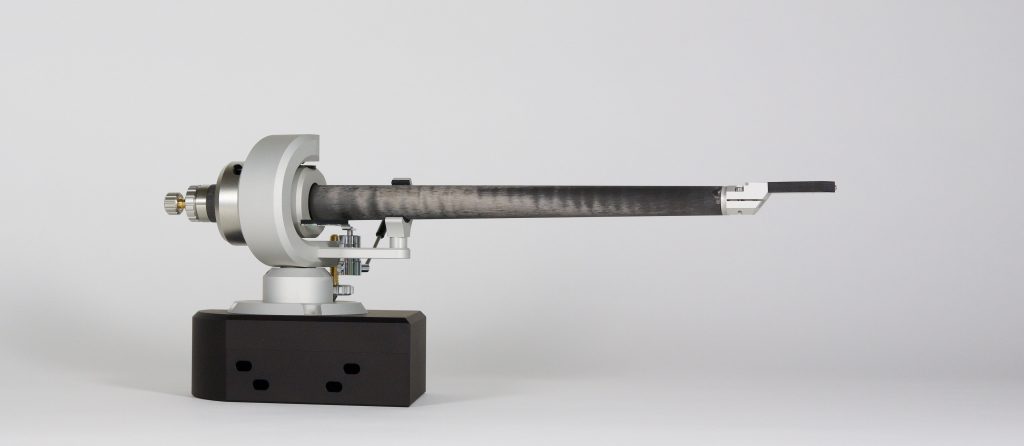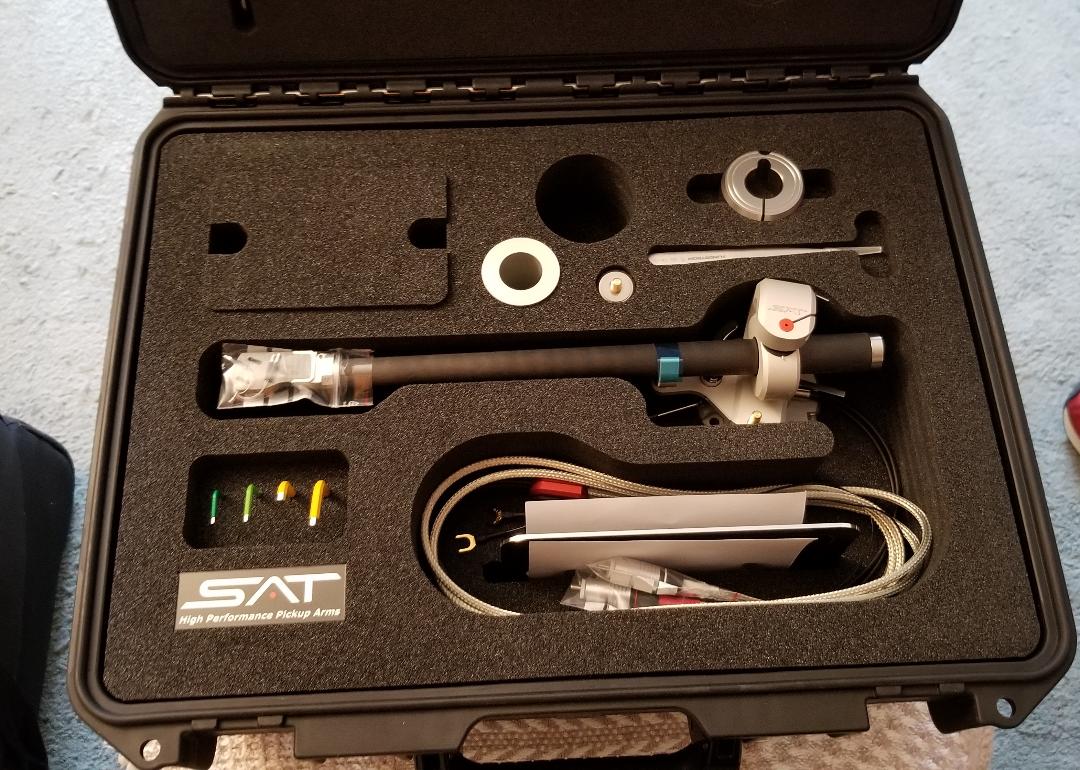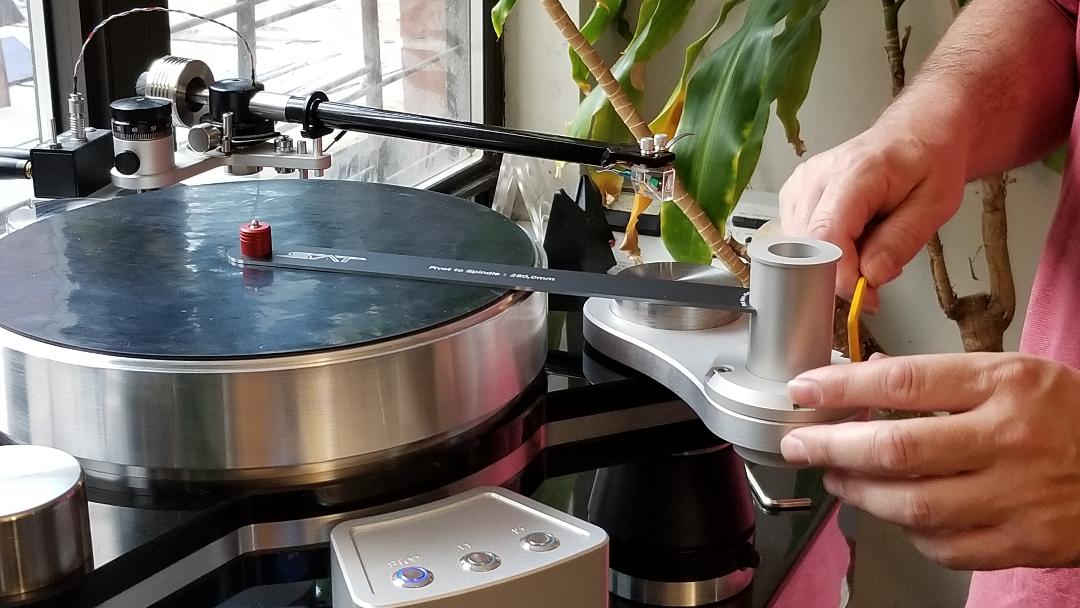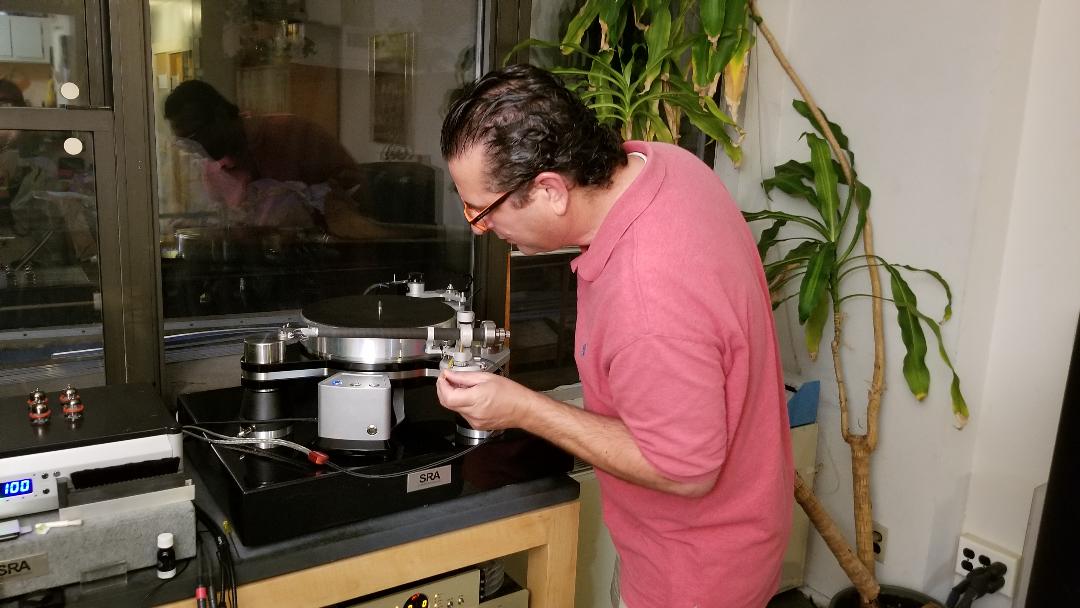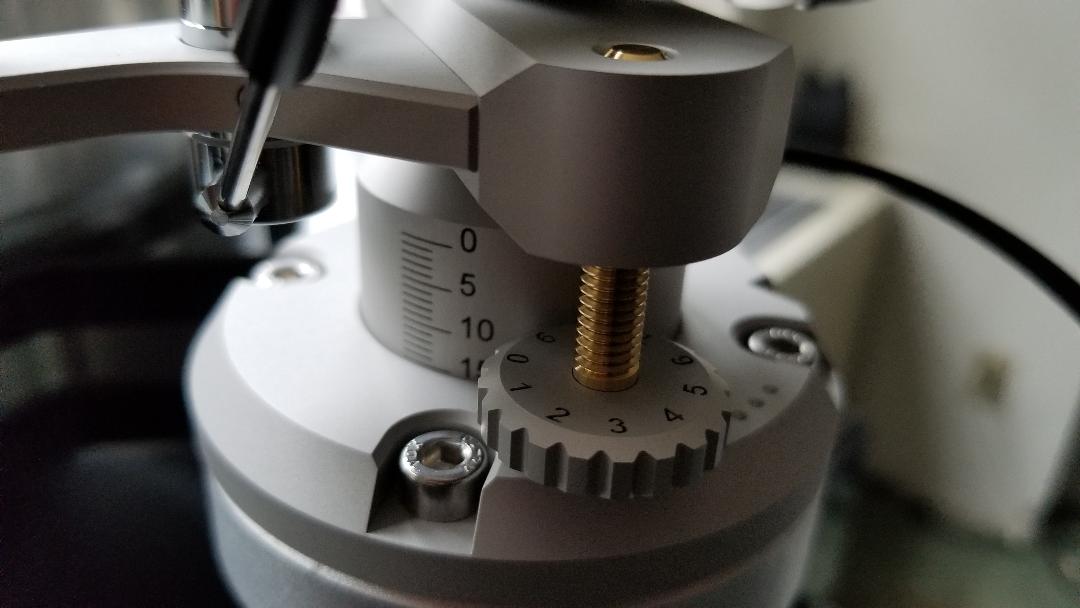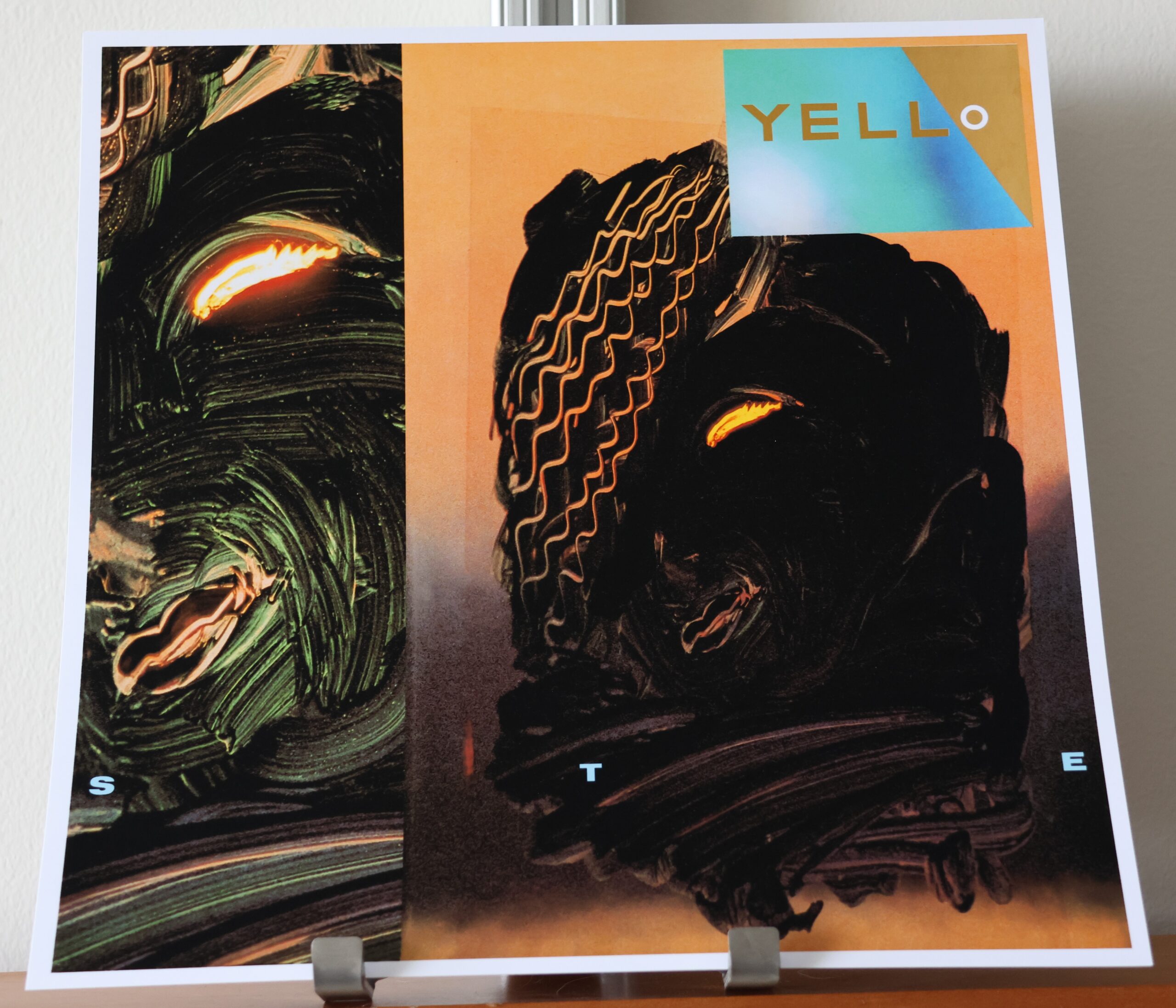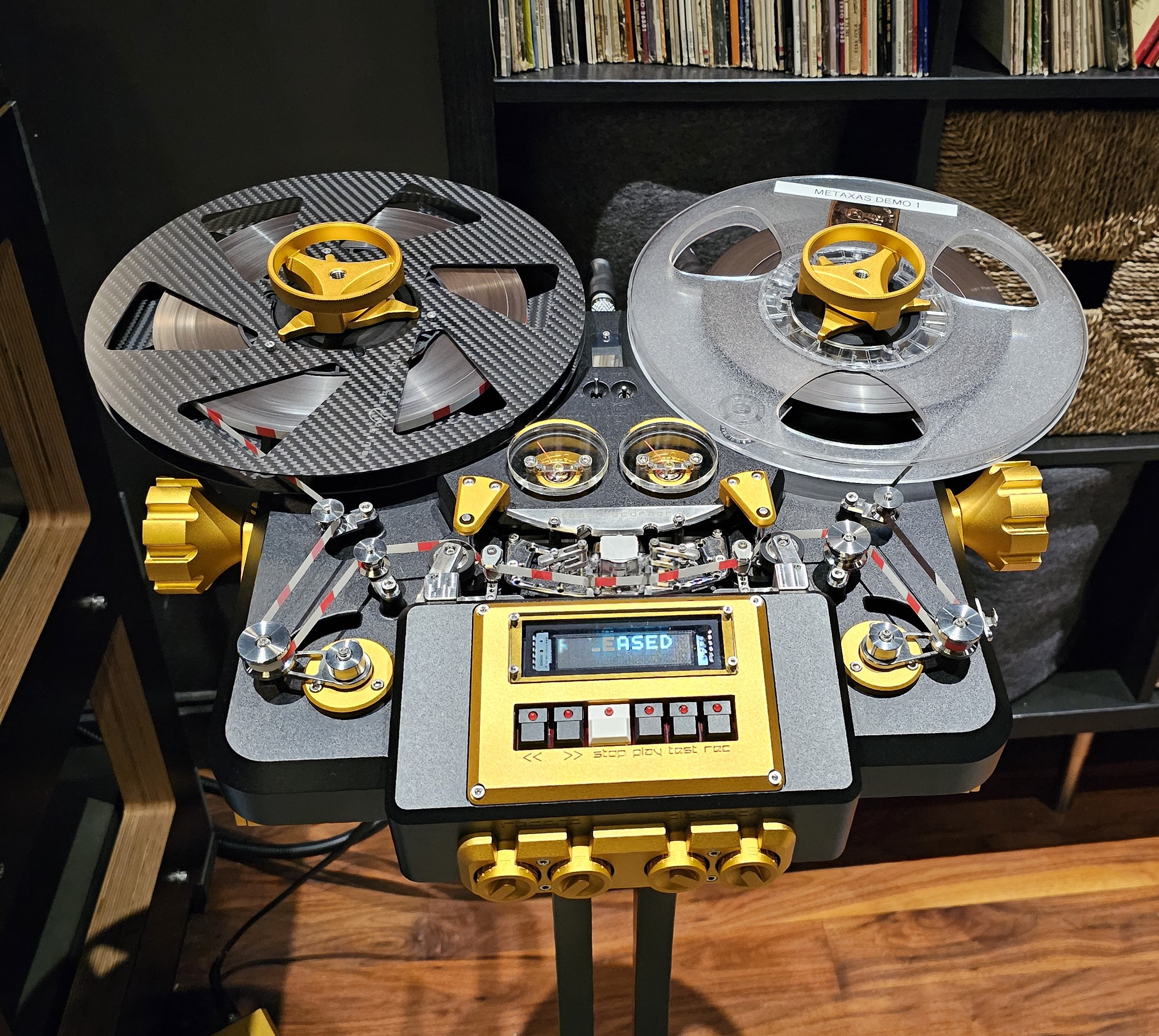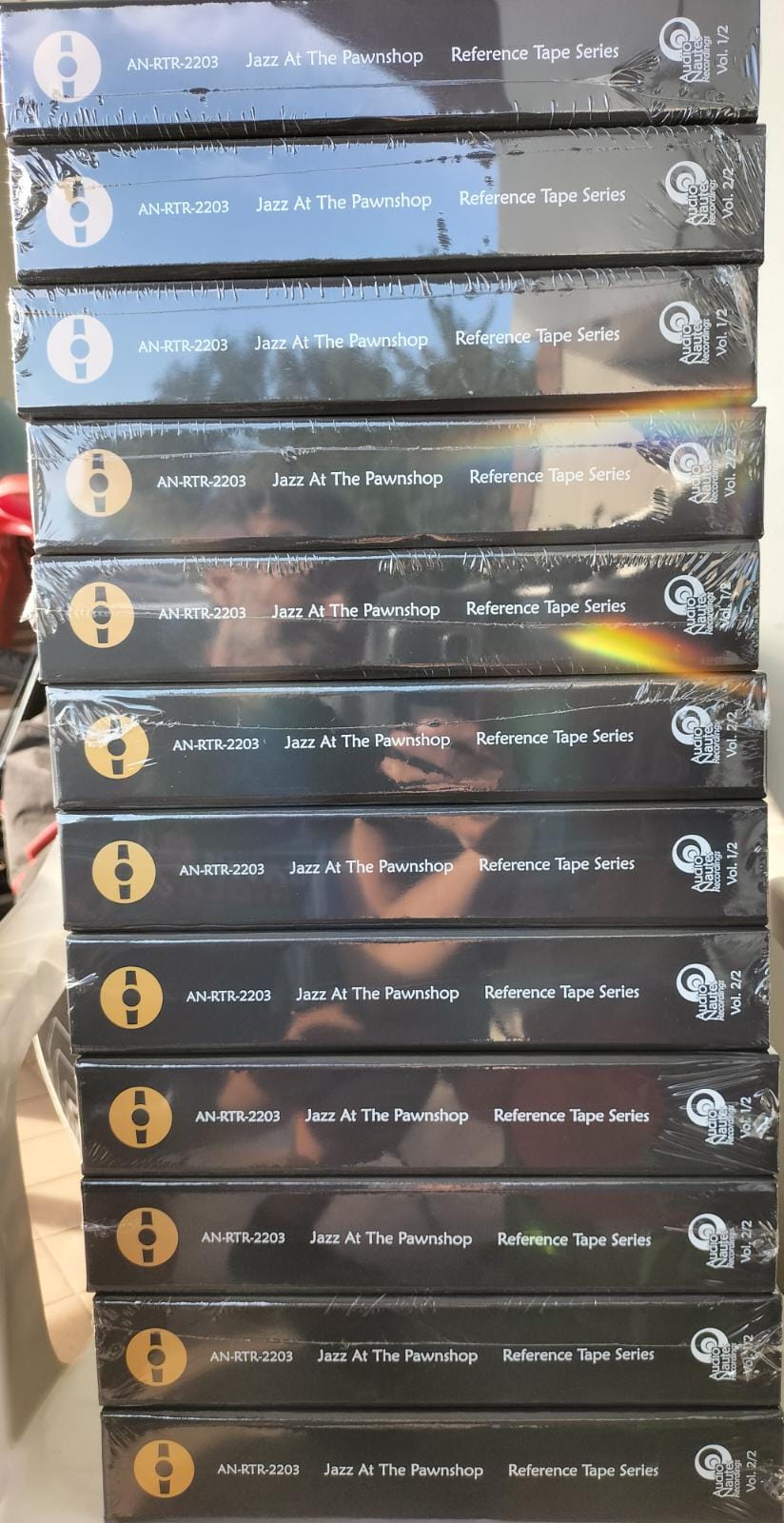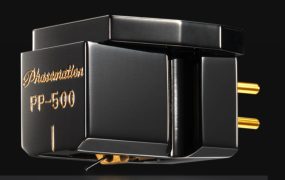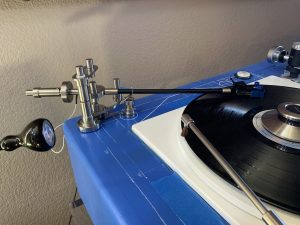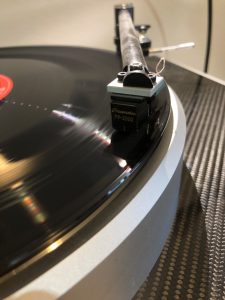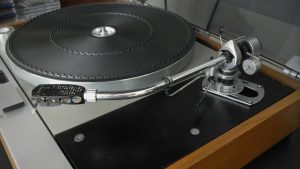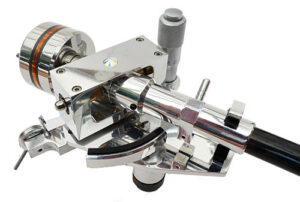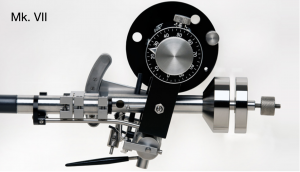The Swedish Analog Technology LM-12 Tonearm
Two of the finest tonearms that I've encountered in my search for the Holy Grail hail from of all places Sweden. The first is the '90s vintage Air Tangent linear tracking, air bearing tonearm that sold for at the time an unheard of $15K (around $30K in today's dollars) in the remote control VTA version. And it was worth every penny of the massive amount of precision machining that went into its manufacturing (commonplace today but cutting edge 30 years ago). The Air Tangent tonearm—for the lucky few that owned this masterpiece—did things that other arms of the day only dreamed about. To this day the Air Tangent's ability to define acoustical space and resolve the finest details from the LP grooves still sticks in my head. Not to mention how the Air Tangent breezed through records that were nearly or totally unplayable with other arms of the day due to scratches, etc. Sadly, the arm's designer Leif Haggemark only manufactured—despite requests from many people (including moi!)—just 100 pieces of this arm. That he sold that many arms almost 30 years ago is above all a testament to the arm's superlative sound and audiophile's quest for the Holy Grail.
The second arm and the subject of this review is designer Marc Gomez's new, no holds barred, Swedish Analog Technology's (SAT) LM-12 tonearm. The SAT LM-12, unlike the Air Tangent, is a gimbal bearing based tonearm employing a straight, 12-inch carbon fiber arm tube (with a detachable and rotable headshell for azimuth adjustment). Marc's first 12-inch arm design is like his first arm defined by its rigidity, stiffness and sound. But more on that in a moment.
Now this isn't my first encounter with a tonearm of the carbon fiber kind. Twenty five years ago, I reviewed the triple layer, woven carbon fiber Wilson Benesch A.C.T. 1 unipivot tonearm (similar in concept to the old Magnepan Unitrac) and the accompanying carbon fiber body based Analog 1 cartridge. (The A.C.T. 1 tonearm was also the first arm in my experience where the counterweight was used set both VTF and azimuth; that led in the day to a lot of cursing). The A.C.T. 1 tonearm was a stark contrast to the other arms of day that often suffered from ringing and resonance artifacts. The A.C.T. 1, by contrast, was very smooth and big sounding but perhaps went a little too far in the other direction sounding a touch reserved, perhaps even a smidge overdamped and darker sound than the typical metal tonearms arms of the day.
Nor is this my first encounter with a Marc Gomez designed tonearm. Marc and his US distributor Maier Shadi, owner of the Audio Salon in Santa Monica, CA, graciously set-up and left me alone with the original 9-inch SAT arm on my VPI Vanquish turntable for a couple of days back in 2016 to do my thing (thanks also to Harry Weisfeld of VPI who took Marc's CAD drawing and instructions and crafted an armboard for the listening sessions; the same armboard was also used for this review). That afforded me time to audition both Marc's personal Atlas as well as the Ortofon A95 cartridge that was in house for review in the original 9-inch SAT tonearm. And it was one of those audio moments that becomes forever ingrained in one's brain for it was obvious from the moment the Atlas commenced playing the "Matilda" track from Harry Belafonte at Carnegie Hall (Classic Records/LSO-6006) that this was a very special tonearm. No hardness. No artificiality. No tension to keep one at arms length from the music. No, this arm just naturally revealed things. The arm's most striking quality was its ability to simultaneously capture and create an eerie, uncannily real feeling of Belafonte strutting around the stage and among and between the various performers.
(Left and right) Marc Gomez (SAT) and Maeier Shadi (The Audio Salon) installing the original 9-inch SAT arm on the VPI Vanquish turntable
"Bob and Ray Visit Dr. Ahkbar at the Castle" from Bob and Ray Throw a Stereo Spectacular (RCA LSP-1773) also illustrated the transparency and resolution of the SAT/Ortofon A-95 combination with new found tactility and detail during the thunderstorm, doors opening and closing, people walking, a wine bottle opened and poured and host of other special effects. You could almost swear Bob and Ray were standing outside the castle of the crazed doctor Ahkbar and feel the slam of the big brass knocker against the door. There was that same visceral gut punch when the tsetse fly morphs into a SR-71 (or I guess back then an X-1) and travels across the stage at Mach 1. Plus—and as I later found out was a function of the arm's geometry—there was no waiting for the first ¾-inch or so of the record to pass before everything locked in. Thus, it was a foregone conclusion to ask Marc and Maier about the possibility of reviewing SAT's new 12-inch.
Pushing the Reviewing Process
First by way of a forward. SAT's latest LM-12 tonearm represents a new wave of cutting edge products pushing the reviewing envelope with their vanishingly low colorations and noise floors. Specifically: are we in this case hearing the "perceived" sonic footprint of the SAT LM-12 tonearm or an attendant coloration elsewhere the reference audio chain? The electronics? The speakers? The cables? The room? Or in this case the cartridge, turntable or phono stage? Teasing out the answer isn't easy and above all requires having a battery of components to substitute in and out of the system during the review process to get a better handle on the product's sonic signature. (It also goes without saying listening to a vast array of albums.) Two different reference moving coil cartridges (Fuuga and Atlas SL), three different amplifiers (conrad-johnson ART300, Merrill Audio Elemente 116 and Ensemble Fuoco integrated amplifier) and a number of different interconnect and speaker cables and power cords (including the newly arrived and super musical Ensemble Dalvivo power cords) saw service at one time or another during the course of the review. It's also just for occasions like that I had put together a top-flight reel-to-reel tape playback front-end so as to have a benchMarc against which to evaluate turntable based front-ends (cartridge/arm/turntable/phono stages). While we all like to think the fidelity is to live music, the truth of the matter is that the ultimate test is against with what is on that master tape and/or what is used for mastering the record.
Second, the SAT LM-12's linearity and lack of overt coloration and/or artifacts allows the end user more than ever to precisely lock in VTA/SRA. Normally cartridge set-up typically requires careful balancing out VTA/SRA vs. loading vs. VTF, etc. Yet in the end it's near impossible, no matter how careful, not to use VTA/SRA as a tone control. Not with the SAT LM-12 tonearm because there's no need to compensate for the sound of the arm. So the teeniest changes in arm height produce large sonic changes in the end. Don't, therefore, necessarily write a recording off if it sounds a little too smooth and/or lacks detail. Or if it lacks a touch of dynamics. Or the spatiality you are used to with your normal setup. Instead, play with the arm's VTA/SRA. The same suggestion applies to cartridge loading or even cartridge tracking force (remember tracking force is suggested value and varies from cartridge to cartridge).
Analog? Obsolete? Hold Your Horses Pardner!
So at long last it was time to fire up the system. First up was the recently reviewed Fuuga cartridge later followed by my long-time reference Lyra Atlas SL (installed with the help of Michael Trei) cartridge in the SAT LM-12 tonearm. Yes, both are moving coil cartridges from Japan but that's where all similarities end. The very first quality that jumped out was how well balanced the SAT was from top to bottom. Next was the LM-12's ability to capture and reveal the subtlest nuances hidden away in those record grooves. Rhythms. Harmonic overtones. Decays. Reverb. Spatial information. The SAT LM-12 tonearm, for example, unleashed even more of the Fuuga's exceptional transparency, spatial and timbral qualities. Take for instance two of Poulenc's choral chansons "Clic clac, dansez sabots" or "Laudes de Saint Antoine de Padoue" from The King's Singers: A French Collection (EMI CSD 3740). The tone of each individual male voice was stunningly rendered replete with surrounding cushion of air. The decay of their voices goes on forever. Not only was there a remarkable sense of transparency but a healthy dose of Windex that wiped that mask off the performer. The SAT really brought to the fore the Atlas SL's simply stunning low end, dynamic
range, effortlessness and extremely fine resolution. Take for instance here the "Autumn Leaves" track from the 25th Anniversary release of the Three Blind Mice album Conversations (Three Blind Mice TBM-43) and the solidity, texture and clarity of Inaba's bass lines. At the same time, the finesse, elegance and accompaniment of Nakamure's guitar is revealed in all its glory. Oh yes. Atlas cartridge haters would be hard pressed to identify the cartridge when mounted in the SAT LM-12 tonearm
In a nutshell, the SAT LM-12 tonearm brings record playback another step closer to the sound of 15-ips reel-to-reel tape. It's important, however, to define the term "tape-like" it's over- and mis-used way too often (especially by those who haven't spent time listening to 15-ips tape). To be sure there are many areas that set reel-to-reel tape apart from LP:
- Tape sounds the same from start to finish;
- Tape has less dynamic constraints especially in the lower octaves;
- Tape doesn't suffer from mistracking issues, particularly on difficult passages/instruments, in the upper octaves;
- Tape has more tonal and harmonic information;
- There's no need to mono or truncate low end response on tape.
Most of all, however, is tape's—and the LM-12 tonearm's—lack of artificiality. Make no mistake: this is not a HiFi-ish sounding arm. The SAT LM-12 tonearm isn't a narcissist constantly craving the center of attention. But just like tape, the more you listen, the more you appreciate the arm's faithfulness to real music and allowing the cartridge to perform optimally. The arm has a decidedly unmechanical sound and lack of tension without that overdamped quality of other carbon fiber based products that have come this way. An ability for the listener to unclench, relax and be absorbed into the music. It's in these areas where the SAT LM-12 truly excels and throws down the gauntlet to other tonearms.
Much been said and written about needing to get the foundation of the music right for the best possible sound and the SAT LM-12 falls into that camp. Get the bass right and imaging, tone and space among other areas snap into place. Above all the SAT LM-12 tonearm sets the standard in this region with its depth, detail, dynamics and most of all ability to unravel and reveal the most complex instrumental textures. Take something like "Song of the Stars" from Mobile Fidelity's excellent reissue of Dead Can Dance's Spirit Chaser (Mobile Fidelity MOFI 2-002). Especially with Ensemble's Fuoco hybrid (tube preamplifier plus solid-state amplifier section) integrated amplifier or the recently arrived Merrill Audio Elemente 116 amplifiers (reviews upcoming) driving the Magico S5 Mk. 2 speakers. The resultant sound here is ever-so reminiscent of tape with its unfettered dynamics and the synthesizer carving out its own portion of space within the soundstage. The viscerality of the instrument grabs, pushes and pulls, vibrates and shakes you to the bones. Not to mention the wonderful potpourri of textures and tones emanating from the instrument. Not to mention the breadth of the recording's soundstage and ethereal quality that swells and completely fills and more the speaker end of the listening room. Quite a reissue of a classic Dead Can Dance album.
The SAT LM-12 also revealed there's still more music lurking away and waiting to be revealed in the grooves on my long time reference LP The Emerald Forest (Varese Sarabande STV 81244). A reference LP has a limitless performance ceiling and continues to reveal more as the system improves and the SAT LM-12 reveals even more of the complex primitive rhythms of Brian Gascoigne's and Junior Homrich's composition "River Paradise" and "End Titles-Eagles Track." Or the chord changes, detail of bass guitar, control and harmonic bloom in low end of Jonas Hellborg's electric bass guitar on Elegant Punk (Day Eight Music DEM LP 004) is another good example of the SAT LM-12's lowest octave performance. No one note bass, smearing or exaggeration in this region. Chord changes are instantly and easily heard.
One is hard pressed to find when it comes to male vocals a better reference album than the aforementioned and classic recording Harry Belafonte at Carnegie Hall (RCA/Analogue Productions AP 45 rpm). Take your pick of songs here: wither "Danny Boy" or "Scarlet Ribbons (For Her Hair)" work equally well. (It should also bears mentioning that the recent addition of Ensemble's Dalvivo power cords to the conrad-johnson GAT Series 2 preamplifier and Doshi V3.0 phono stage allowed even more of the SAT LM-12's potential to be realized and elevated the arm's and system's midrange, bass, imaging and transparency too to new levels.) There's a point now where the palpability of Belafonte's then youthful voice smashes through the boundary between 3D image and wrap your arms around his body. New found, subtle, low level of musical details give a whole new level of depth to Belafonte's voice. So much more life and an emotional connection.
"Chitlins Con Carne" from Kenny Burrell's Midnight Blue (Blue Note/Analogue Productions AP 84123 45 rpm) is another great example of the arm's midrange and instrumental timbre. This album is one of Burrell's best known albums and Blue Note's best recordings all rolled together in one package. Burrell, "always had a love for the blues. In my earliest days in Detroit I worked with groups that concentrated a great deal on the blues. I wanted to get a group together for this session that can feel the blues just the way I do." This particlar track epitomizes those classic blues compositions with its call and response heard here between the young 31 year old Burrell and Turrentine on saxophone. There's just a rightness to the tone of Burrell's guitar characterized by an incredible density of body and balance between the purity of individual notes/chords and harmonic bloom. All this is made even more evident by the transparency of the arm.
Another area that separates tape from LPs is upper octave performance namely percussive type instruments. Here the SAT tracks those grooves like it has no right to and that shows up in many ways such as tracing everything from the most difficult passages as well as recreating those feathery soft cymbals. Take for instance vibes that for the most part exhibit some degree of strain (unlike with tape) on Milt Jackson's Sextet Invitation "Ruby My Dear" (Mobile Fidelity MOFI1-298). The SAT LM-12 tonearm, on the hand, sails through the same passages and exhibits some of the best tracking, upper octave extension and delicacy of any arm.
Finally, the SAT LM-12 tonearm throws with either the Fuuga or Atlas SL cartridge onboard an E-normous soundstage. It's as if a 20 kiloton tactical nuclear battlefield weapon has blown the walls away and opened up the soundstage. Take for example Yello's crazy good 12-inch maxi-single The Race (Fontana 870 330-1). This album has it all. Power and authority! Low end. And a real pulsing groove. But let's just focus for the moment on this recording's soundstage. Everything including the speakers and walls completely disappear leaving the room awash in a kaleidoscope of sounds. There's so much depth that swear there are things happening across the street. From the opening F1 car shooting past that viewing spot in the stands to the voice's haunting sounds to each instrument precisely carving out their niche in space to the wowie zowie layering of instruments. All made even more impressive due to an extremely generous triple helping of transparency.
There's An Amazing Amount Of Information Buried In Those Grooves
Tonearms are notoriously the most under-appreciated piece of the analog playback chain (cartridge, tonearm, turntable, phono cables and phono stage). Let's be honest. There's nothing sexy about tonearms. Audiophiles are far more apt to swap out their cartridge, table or phono stage before even giving a moments consideration to upgrading the tonearm. Yet cartridges can't perform at their best without a properly designed, stable and non-resonant tonearm.
SAT's latest LM-12 tonearm might not be as sexy as a new turntable but this instrument pushes the limits of analog playback and markedly elevated the performance of both the Fuuga or the Atlas SL cartridges. What stands out the most about this tonearm—out of its arm's length list of strengths—is the LM-12's overall balance. Nothing is out of place. Everything from the deepest lows to the highest highs are perfectly balanced like Mr. Olympia's body. Digging deeper, the new SAT LM-12 really set the standard when it comes to low end reproduction and midrange timbre and sense of ease. The arm's neutrality, transparency, timbre, dynamics, naturalness, holographic imaging and more are simply rare as hen's teeth to find in one tonearm. The tonearm won't gloss over bad recordings. Yet even they benefit because the tonearms adds less colorations during vinyl playback. Most of all, the SAT LM-12 will elevate the best recordings in your collection to levels never imagined revealing information you never knew existed on your favorite LPs.
One interesting observation. A leading tonearm designer opined several years ago at RMAF that cartridges are impossible to review since they won't sound the same in any two arms. That certainly piqued my curiosity and certainly wasn't my experience listening to the Fuuga or Atlas SL in either the VPI dual pivot or SAT LM-12 tonearms. The basic character of both cartridges remained constant in either arm. What did vary was the degree of resolution, finesse and balance of virtues from top to bottom of the audio spectrum. But one cartridge wasn't bright and unlistenable in one arm and a gem in the other. That is what would be expected in well thought out, designed and manufactured tonearms.
Yes, the SAT-12 tonearm is expensive but it's absolutely worth every penny. This tonearm really delivers the goods and met or exceeded everyone's expectations (and some high ones at that) who heard the arm in my system. This tonearm will change the way those die-hard audiophiles who can afford this tonearm listen to their albums. It certainly did and continues to do so for me.
Technical Highlights
Much has been written about Swedish Analog Technology's (SAT) tonearm designer Marc Gomez's professional accomplishments including an advanced degree in mechanical engineering and a background that includes, "extensive work in the development and manufacturing of parts made of composites, which is crucial to achieve the high levels of rigidity and internal damping…"
Marc put that extensive knowledge to use in the design of his original 9-inch SAT tonearm and currently in the latest SAT LM and CF1 series of tonearms. He uses whatever tools are necessary when designing his tonearms including but not limited to CAE (computer-aided engineering), CAD (computer-aided design) and FEM (finite-element method) to calculate his arm's moment of inertia, their natural frequency and resonance modes. (something that a few speaker manufacturers are using nowadays too for among other things speaker cabinet design though the price of the software replete with all the modules can run as high as $250k). CAE, for example, allows Marc to "simulate deformation of different materials in the arm under load and decide what geometry and material combination to use to achieve the design targets." (that includes even the clamping/tonearm rests and arm base.) FEM enables him, "to analyze the natural frequencies and modes of the arm and headshell. "The software is used to assess modifications to the arm and their impact. The upshot is that Marc leaves nothing is left to chance. He continued, "I do all the design and development work in my head, on paper and then finally on the computer. When I am satisfied with the performance on paper, a pre-production arm is built to assess its actual performance through listening. Then, I am able to verify whether the different steps in my design have yielded the expected sonic results and how much of an impact they have in the final sound. Until now, in every occasion, the improvements that I predicted during the development phases have always been realized every time I have built the first unit of a model. I do not build any physical prototype until I have spent many hours analyzing and thinking about the problems to be solved to achieve a certain performance or feature."
Marc's design philosophy is easily summarized by, "…pickup arms should be designed and manufactured as precision measurement instruments, rather than as tuned musical instruments. We strive to, though, to create designs which have an elegant, technical and attractive look without compromising their mechanical integrity. Also to last a lifetime, even generations. SAT arms are," Marc explains, "designed to be very rigid and have high structural integrity, thus providing a more stable platform for the cartridge to operate." To achieve his objectives Marc, "chooses materials and geometries that provide the desired mechanical performance of the arms—always based on the laws of physics and proven engineering practices. He has partnered with the finest workshops in Sweden and Europe that make advanced precision components to companies such as Hassselblad." Yes, Marc emphasizes performance over looks but the LM-12 has a very unique and sexy look to it. Just like that rounded shape of a bottle of burgundy.
The latest generation of SAT arms incorporate many improvements learned during the design, manufacturing and field operation of Marc's initial 9-inch SAT arm (released in 2015). Enough changes, in fact, to confidently say that the newest SAT LM-12 and the original 9-inch tonearm are very different critters. Among the design and manufacturing changes incorporated into the newest 12-inch arm are:
- SAT's first 12-inch tonearm;
- A larger diameter and larger cross-sectional arm tube (minus the polymer sleeve of the original arm). The new tonearm uses same original grade epoxy-pre-impregnated fabric carbon fiber but incorporates a different laminate and geometry for optimal stiffness-to-weight ratio;
- The 12-inch arm uses a new proprietary, sealed, vertical plane (stiffer) bearing; the arm also uses the same horizontal protected Tungsten carbide point on sapphire jewel bearing design used in the new CF1 series;
- A new Al (in place of stainless steel) yoke;
- A new, multi-plie hybrid Al/carbon fiber headshell;
- VTF is adjusted using counterweight and one of two lockscrews (with different masses) to fine tune tracking force;
- A more sophisticated method was developed to preload the bearings and avoid damage during shipping.
Marc also turned to new machining tools and techniques during the manufacturing process in order to, "obtain the fine finish we require is without damaging the delicate fibers. Complicating matters," adds Marc, "is that carbon fiber is a beast to work with and wears out cutting tools very quickly…"
"Nor are all carbon fiber composites," Marc points out, "are created equal." Marc's goal is taking full advantage of what carbon fiber has to offer in the new SAT LM-12 tonearm. That's in contrast to simply substituting, "off the shelf carbon fiber components that lack the required stiffness of the laminates SAT developed and do not come in the geometries required for high rigidity" for another material like aluminum, wood, etc. The heart and soul of the LM-12 tonearm are pre-preg carbon fiber fabrics that are CNC modeled, machined and then sequentially tool laid to create a complex physical structure of multiple plies with varying stiffness and thickness in order to optimize the arm's mechanical properties. Key to obtaining the prerequisite rigidity and stiffness is placing, "fibers along the directions where stiffness must be high." When all is said and done, the tube and headshell are constructed from 20 and 40 plies, respectively, of carbon fiber material.
After being mounded, the parts are cured for several hours in a specially designed autoclave under defined temperature and pressure conditions (these autoclaves are also used for satellites and other high-tech materials). This curing process is extremely labor intensive with materials being in short supply. At the end of curing process, the parts are then taken out of the autoclave and allowed to cool down before being removed from their tooling. The carbon fiber blanks are then CNC machined and hand finished by Marc. Several days elapse before the carbon fiber parts can be assembled with the other components."
These in-house designed and custom produced carbon fiber arm tubes have extremely high first natural resonances. The first natural resonance for the LM-12 comes in at 2050Hz while the CF1-09 is as high as 4030 Hz. Marc noted that, "the higher the fundamental resonance of the arm and components (headshell, arm tube, bearings, etc.), the lower the amplitude of the vibrations and smallest amount of harmonics within the audio frequencies." English please? Shorter and stiffer arm lengths like the CF1 series translates into higher resolution and more defined transients.
The LM-12 tonearm is also "dynamically balanced" so the vertical and horizontal axes are at the arm's center of gravity. Marc explains, "any movement of the arm in one plane does not cause a reactive movement in another plane. The vertical movement of the arm due to a warp will not create a reactive movement sideways as it would occur had the center of gravity not been at the center of rotation. Nevertheless, due to the design of the bearings for the movement in the vertical plane, a change in the height of the arm will slightly alter the VTF and that is why I added compensation charts for that."
Heavy duty Pelican cases are used to minimize any chance of shipping damage to the SAT LM-12 tonearm
Everything about the SAT arm exudes class and pride of ownership; no detail, no matter how small, is overlooked. The feather-like feel of the arm; no slop during VTA adjustment; and the ability to accurately and reproducibly adjust VTA on the fly. That attention to details trickles down to the accompanying owner's manual, packing and setup tools. Marc, in fact, assembled the most thoroughly written owner's manual—not just for a tonearm but any high-end audio product—that I've seen in all my years of reviewing. Follow this road map to obtain the best in sound from the SAT arm. One example of the Marc's meticulous attention to detail is the inclusion of a "VTF compensational" table into the owner's manual (yes, I did read it from cover to cover). This correction factor is added to the measured VTF to take into account the difference in height between the record and the height of your VTF gauge. For example: 1) for 1 mm add 0.05 g to the tracking force; 2) for 2 mm add 0.08 g to the tracking force; 3) for 3 mm add 0.1 g to the tracking force; and 4) for 4 mm add 0.11 g to the tracking force. My biggest issue with the LM-12 was dressing the tonearm wire with the Atlas. It took quite a bit of work and time to prevent the excess wire from touching the LP.
A few other pertinent design details of the SAT LM-12 tonearm: The arm is internally wired with instrumentation grade silver-plated and Teflon insulated copper wire that runs uninterrupted from the cartridge to the phono stage; this eliminates a potential source of sonic degradation. The armrest lockdown is well thought out, really holds the arm in place and a joy to use. The cuing mechanism treats cartridges like they're worth a million dollars and lowers that precious transducer onto the record oh-so gently. After all, it's the cuing process that more often than not results in the most stress to the cartridge's delicate suspension.
Mounting the SAT LM-12 arm on the VPI Vanquish table is a snap (the Vanquish table is an excellent and accommodating platform for the vast majority of tonearms). All that's required is the correct armboard and it's off to the races. SAT also provides armboards for a wide range of turntables including but not limited to Continuum, TechDas, Brinkmann, Kronos, Rui Borges, SME and many other tables. In this case, Harry Weisfeld of VPI was kind enough to work with Marc to provide an armboard that worked with my VPI Vanquish turntable.
Maier Shadi, The Audio Salon, setting stylus-to-pivot distance for the LM-12 tonearm
Maier Shadi, owner of The Audio Salon in Santa Monica, CA and US distributor for SAT products installed the arm for this review. Each arm comes with a special tool for setting stylus-to-pivot distance plus three different size spindle adapters (since tables may have slightly different diameter spindles) to eliminate any chance of slop when setting stylus-to-pivot distance. Setting the stylus-to-pivot distance on the Vanquish simply involves loosening the arm board's lock screw and rotating the arm board until the distance is at 280 mm.
The next and most difficult step in the setup process follows. Luckily installing and loading the horizontal sapphire playback bearings are carried out by the authorized dealer in charge of installing the arm. A new bearing system was developed to protect the bearings during shipment and removed when the arm is installed. Here too Marc developed a special tool for the newest generation of SAT arms that simplifies and makes the bearing loading process absolutely reproducible. The new bearings—unlike the original SAT arm—don't need to be adjusted for different compliance cartridges due to their design.
Maier Shadi doing some fine adjustments on the arm
Then the two-point, modified, Lofgren-B based protractor is removed from the arm's carrying case and used to align the cartridge. This SAT LM-12's protractor's geometry is based upon an innermost groove radius of 75 mm and an outermost groove radius of 143 mm. Marc arrived at theses inner and outer groove radii numbers based on the number of records typically found in a varied collection with grooves running into the label (this geometry must be used for maximal performance). SAT supplied headshell screws should also be used when mounting all cartridges and an apply an equal and opposite torque resistance to protect the bearings should always be used when tightening down the headshell screws or the collar locking mechanisms. Again, this process is nicely illustrated in the owner's manual.
Once the cartridge is aligned, it's time to set VTF (vertical tracking force). This is a fairly uncomplicated process using the large counterweight for gross downward tracking force and one of two locking screws for fine adjustment. Setting VTF to hundredths of a gram was a walk in the park using these locking screws. Which locking screw to use? "Choose the smallest locking screw," according to the owner's manual, "that allows the counterweight to be further back for the required VTF. This will provide higher sonic performance from the arm."
The next step it to adjusting VTA/SRA. That's easily done by unlocking one set screw on the arm base collar (after having followed adjustments for the four screws locking down the arm collar). Dialing in extremely fine and on the fly reproducible adjustments is no problem here! Converting turns to degrees is also a breeze and simply requires pulling up the appropriate table in the owner's manual. One complete 360 degree turn of the height adjustment wheel equals 1 mm (a calibrated height scale is located on the arm pillar), each number (1-10) on the height adjustment wheel equals 0.1 mm and one degree of movement equals a change of 5.2 mm for the SAT LM-12. So all that's left is doing simple math!
Then it's onto setting cartridge azimuth. There are a number of different ways to set azimuth including the Fozgometer (that uses crosstalk) or software-based methods such as those from Feickert (that uses either crosstalk or phase) or the newer AnalogMagik (that uses distortion measurements). Marc, however, suggests (and recommends) setting azimuth optically for maximum performance and tracking accuracy. The idea here is that the correctly aligning the stylus' footprint in the groove is more important than the electrical properties. I tried both ways and found trade-offs with each. Optical setting sounds a bit smoother but electrically setting provides more body. Lastly, additional headshells are available for those who like to swap different cartridges in and out.
Finally, anti-skating is set using a filament-based system that produces constant torque across the album. Marc doesn't recommend setting anti-skating either with test records and instead recommends using the "standard" hardware supplied with the arm that includes 3 washers that he explains is, "… optimal for most modern cartridges tracking at 1.5 to 2.5 g. Mass only needs to be decreased when tracking at values lower than 1.5 g." I found three worked fine with the Fuuga but two were a smidge better with the Atlas SL.
Adjustments
- Stylus-to-pivot distance: 280 mm
- Offset angle: 20.3 degrees
- Innermost groove radius: 75 mm
- Outermost groove radius: 143 mm
- Nominal linear offset: 103.4 mm
LM-12 Tonearm
Retail: $31,250
Swedish Analog technologies




